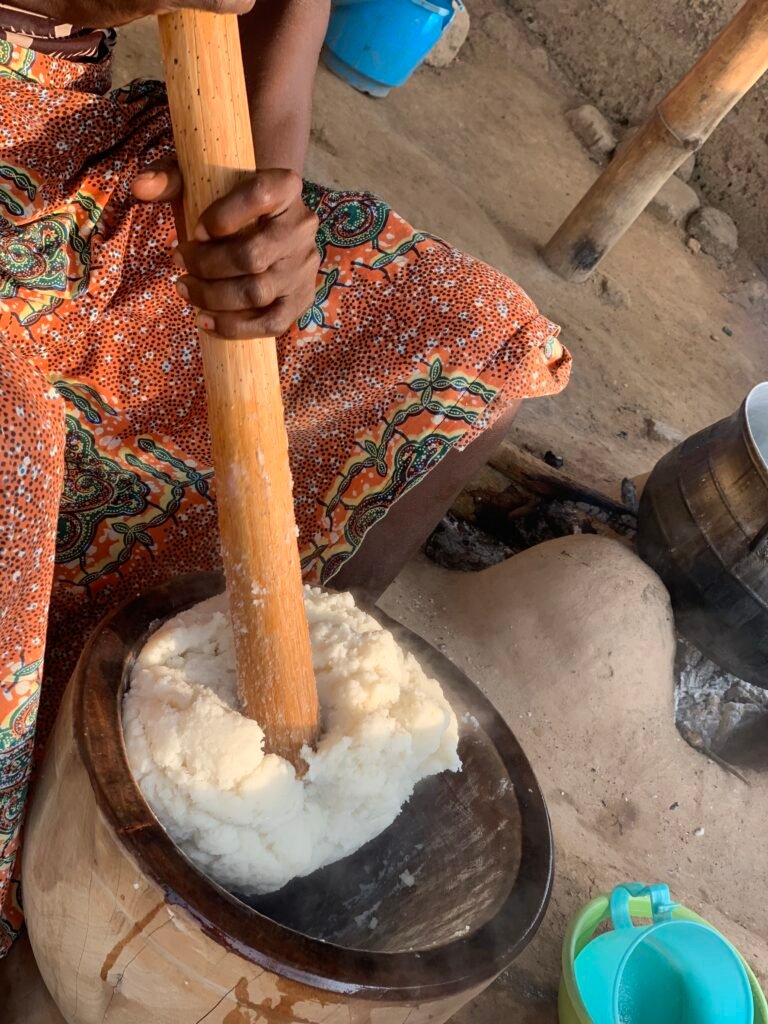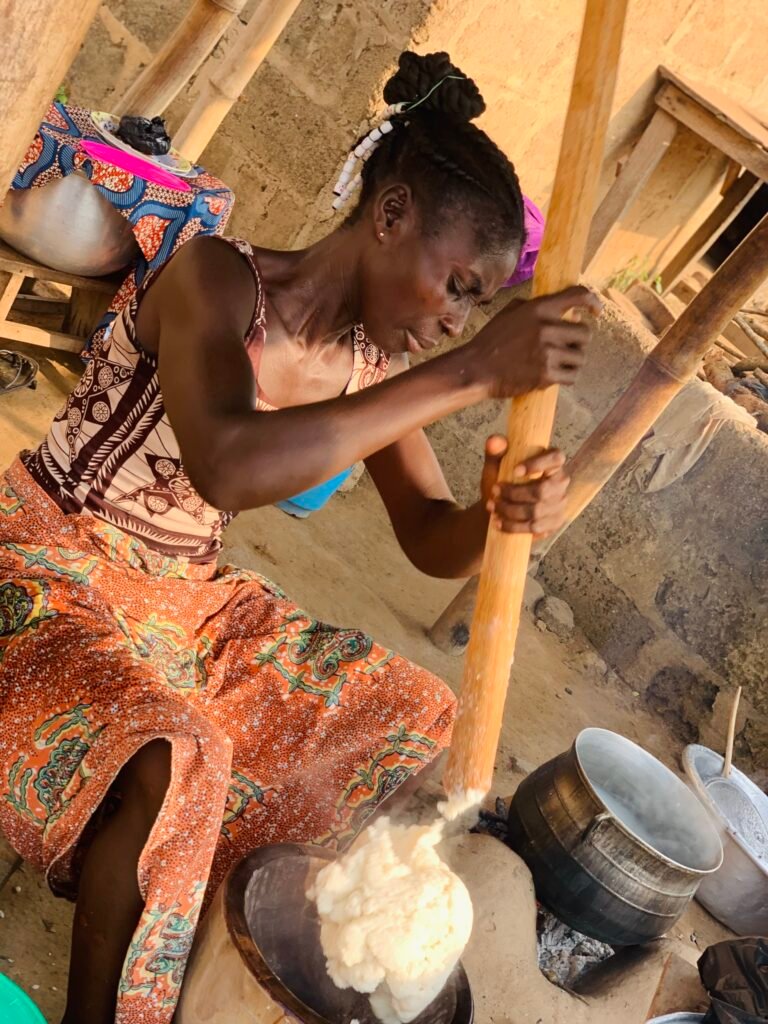
A red corn fomfom. Source: @benyiakofikyei on X
The Ahanta people of Ghana have a unique way of preparing their meals, and Fomfom is one of their well-known traditional dishes. This meal is enjoyed for its taste, nutritional value, and the way it brings people together. Made with simple ingredients that are easy to find, Fomfom shows how the Ahanta people use what is available to create something special. In this article, we will look at what goes into making Fomfom, from the ingredients to the cooking process. This dish is often prepared for family meals, gatherings, and special occasions. Learning how it is made gives a better understanding of Ahanta food and the effort that goes into preparing it.
The Ahanta people are an ethnic group primarily found in the Western Region of Ghana, particularly along the coastal areas stretching from Axim to Sekondi-Takoradi. They speak Ahanta, also known as “Aɣɩnda,” which is a dialect of the Akan language family. Although Akan is widely spoken in Ghana and parts of Côte d’Ivoire and other West African countries, Ahanta is considered a minority dialect with fewer native speakers and users (Obeng, 2021).
According to the 2021 Population and Housing Census (PHC) conducted by the Ghana Statistical Service, the total population of Ahanta speakers in key districts such as Ahanta West, Effia-Kwesimintsim, Sekondi-Takoradi, and Shama stands at 689,721. Despite their relatively smaller numbers, the Ahanta people have a strong presence in the region, maintaining their traditions, language, and way of life.
Food plays an important role in every culture, providing energy and nourishment. For the Ahanta people, their traditional dish is Fomfom, known in Ahanta as Fomfomi. This meal is one of the many maize-based dishes found across Ghana. As mentioned earlier, maize is the main ingredient in this unique dish.
Unlike other maize dishes in the country, preparing Fomfom requires a lot of time and careful attention. The process is detailed and demands patience to achieve the right texture and taste. Though not widely known, Fomfom remains a cherished meal among the Ahanta people.

Fomfom comes in three main varieties, each with its unique preparation method. The first type, White Fomfom (Fomfomi Fuvulo), is made by removing the maize chaff before grinding it into corn dough for cooking. The second type, Chaff Fomfom (Avɔdɔlɛ Fomfomi), includes both the maize and its chaff, resulting in a slightly yellow appearance. The third variety, Red corn Fomfom (Fomfomi Kɔkɔlɔ), is prepared using a special red maize, giving it a distinct reddish color. Each of these variations offers a unique texture and taste, reflecting the diversity of Ahanta cuisine.

After reaching a certain stage of cooking, the dough balls are removed from the boiling water and crushed in a special Fomfom mortar and pestle, which resembles the one used for pounding palm nuts. At this point, the mixture still appears undercooked. Once crushed into a powder-like form, the hot boiled water is gradually added and mixed using the pestle to create a smooth, solid mixture. The dough is then reshaped into ball-like forms with the palm, but this time, a hollow is created in each ball using the thumb. This hollow allows the hot water to penetrate, ensuring the Fomfom is thoroughly cooked.
Regardless of the type of maize used, the preparation process remains the same. First, the corn dough is prepared, and water is brought to a boil. The dough is then mixed with a room-temperature water and shaped into small ball-like forms. These dough balls are carefully placed into the boiling water for an initial cook, allowing them to firm up before the next stage of preparation.

Once fully cooked, Fomfom can be eaten raw by sprinkling salt over it. In this form, it is known in Ahanta as Niya Apuko, meaning “An Ahanta kenkey that is broken to eat,” as it is traditionally broken into pieces before being enjoyed. However, the real transformation happens in the mortar and pestle. Since the uncooked dough was previously crushed in the mortar, both the mortar and pestle are thoroughly washed to remove any remnants of raw dough. Salt is then added to the clean mortar, and the cooked hollow balls of Fomfom are placed inside one at a time. They are pounded to achieve a soft texture, with the process being enhanced by the addition of boiled water. This hot water thickens into a slightly dough-like liquid known in Ahanta as Sibe, which is gradually poured over the pounding dough until a smooth and even consistency is achieved. This final product is what is called Fomfomi.
Apart from Fomfomi, Sibe is also known for its health benefits. It can be enjoyed as a porridge, with sugar and milk added for taste. Additionally, raw Sibe is considered a natural remedy for malaria and fever. Traditionally, whenever Sibe is prepared, members of the household are encouraged to bring a cup to drink while it is still hot, as it is believed to help treat any hidden symptoms of malaria or fever.

Now back to Fomfom. It is best enjoyed with Kako stew. Kako is a well-known Ghanaian dried salted shark or whale, cut into rectangular pieces. In the Western Region, it is popularly referred to as “Ahanta meat” due to the Ahanta people’s love for it. Aside from Kako stew, Fomfom can also be enjoyed with fried fish or and shrimp accompanied by a spicy raw or cooked sauce. Additionally, it pairs well with any dish typically served with Banku, such as soup, okra stew, and other flavorful accompaniments.
Fomfom is not just a meal but a cherished part of Ahanta culinary tradition, prepared with care and enjoyed in various forms. Whether eaten raw with salt, paired with Kako stew, or served with fried fish and spicy sauces, it remains a unique and satisfying dish. Beyond its taste, the nutritious Sibe adds a health benefit, making Fomfom a wholesome food choice. Whenever you visit the Western Region, especially the Ahanta West District, be sure to experience the rich flavors of Fomfomi with Kako stew, an authentic taste of Ahanta heritage.
Editor: Ama Gyesiwaa Quansah






